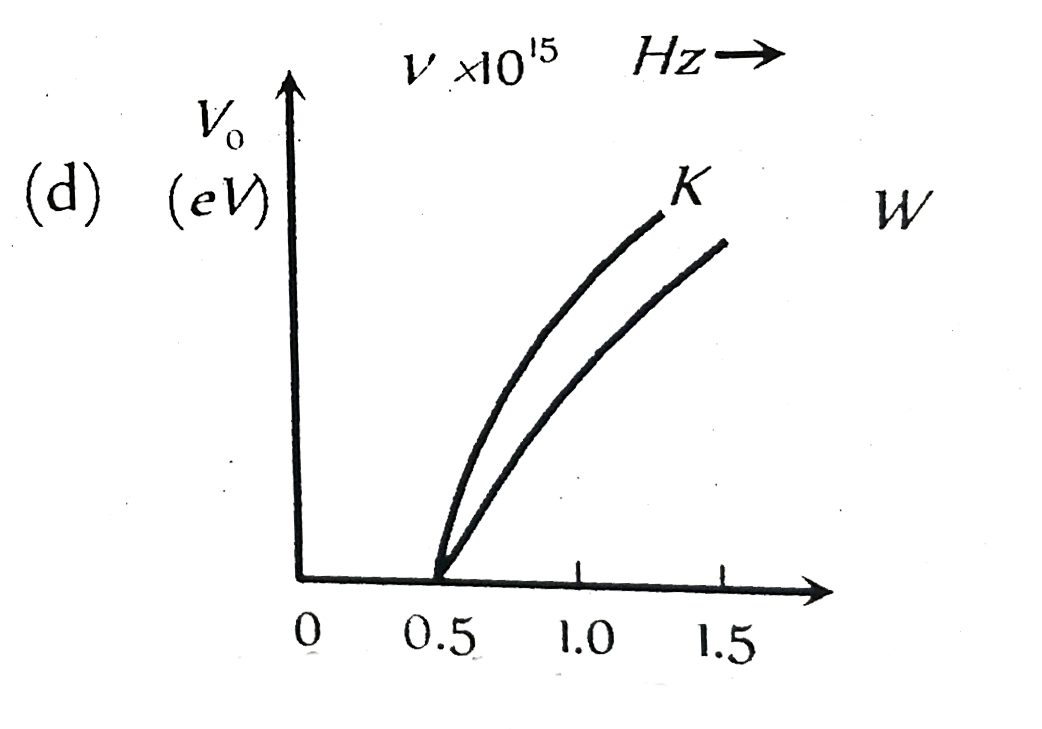When light of frequency v1 incident on a metal with work function W0 (where hv1>W0), the photocurrent falls to zero at a stopping potential of V1. If the frequency of light is increased to v2, the stopping potential changes to V2. Therefore, the charge of an electron is given by
W0(v2+v1)v1V2+v2V1
W0(v2+v1)v1V1+v2V2
W0(v2−v1)v1V2−v2V1
W0(v2−v1)v2V2−v1V1
The correct Answer is:C
Step by step video, text & image solution for When light of frequency v_1 incident on a metal with work function W_0 (where hv_1 gt W_0), the photocurrent falls to zero at a stopping potential of V_1. If the frequency of light is increased to v_2, the stopping potential changes to V_2. Therefore, the charge of an electron is given by by Physics experts to help you in doubts & scoring excellent marks in Class 11 exams.
Updated on:21/07/2023Topper's Solved these Questions
- ELECTRONS AND PHOTONSBOOK - TARGET PUBLICATIONCHAPTER - ELECTRONS AND PHOTONSEXERCISE - Evaluation Test
19 Videos
- ELECTRONS AND PHOTONSBOOK - TARGET PUBLICATIONCHAPTER - ELECTRONS AND PHOTONSEXERCISE - Critical thinking
22 Videos
- COMMUNICATION SYSTEMSBOOK - TARGET PUBLICATIONCHAPTER - COMMUNICATION SYSTEMSEXERCISE - Evaluation Test
15 Videos
- FORCE BOOK - TARGET PUBLICATIONCHAPTER - FORCE EXERCISE - Evaluation Test
16 Videos
Similar Questions
Find the frequency of light incident on a metal surface if the photocurrent is brought to zero by a stopping potential of 2.6V. The threshold frequency for the metal surface is 5×1014/s .
View SolutionWhen light off frequency v1 is incident on a photosensitive surface , the stopping potential is V1 . If the frequency of incident radiation becomes v1/2 the stopping potential changes to V2 Find out the expression for the threshold frequency for the surface in terms of V1andV2
If the frequency of incident radiation is doubled , will the maximum kinetic energy of the photoelectrons also be doubled ? Given reason .
View Solution
Knowledge Check
When light of wavelenght λ incident on a metal then stopping potential is 10V. If wavelengt is increase to 3λ then stopping potential is 2V . Which of the following can emit electron form the metal : -
A5λB7λC9λD10λThe figure showing the correct relationship between the stopping potential V and the frequency v of the light for potassium and tungsten is
A B
B C
C D
D
Choose the graph showing the correct relationship between the stopping potential V0 and the frequency v of light for potassium and tungsten.
A B
B C
C D
D
The frequency (v) of the incident radiation is greater than threshold frequency v0 in photocell. How will the stopping potential very if frequency v is increased, keeping other factors constant.
View SolutionWhen ultraviolet radiation of a certain frequency falls on a potassium target, the photoelectrons released can be stopped completely by a retarding potential of 0.6 V. If the frequency of the radiation is increased by 10%, this stopping potential rises to 0.9 V. The work function of potassium is
View SolutionWhen ultraviolet radiation of a certain frequency falls on a potassium target, the photoelectrons released can be stopped completely by a retarding potential of 0.5 V. If the frequency of the radiation is increased by 10 %, this stopping potential rises to 0.9 V. The work function of potassium is
View SolutionWhich of the following is the graph between the frequency (v) of the incident radiations and the stopping potential ?
View SolutionFor intensity I of a light of wavelength 5000Å the photoelectron saturation current is 0.40μA and stopping potential is 1.36V , the work function of metal is
View Solution
